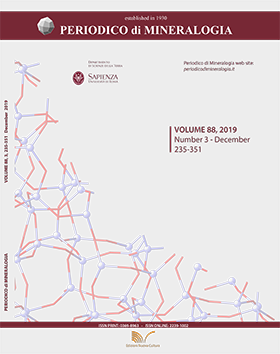Irankuh lead-zinc mining district, southern Isfahan, Iran: Evidences of geology, fluid inclusion and isotope geochemistry
DOI:
https://doi.org/10.2451/2019PM867Keywords:
Ore-forming fluid, Sulphur isotope, Lead isotopes, MVT, Irankuh, IranAbstract
Irankuh mining district is one of the most important Pb–Zn MVT-type mineralization, which is located in Malayer-Isfahan Metallogenic Belt (MIMB), Western Iran. The deposits are hosted by Cretaceous dolostone and minor Jurassic shale. Hydrothermal alteration minerals are composed of dolomite, Fe-rich dolomite, ankerite, and minor quartz. Hypogene minerals are sphalerite, galena, and bitumen associated with minor pyrite, chalcopyrite, and barite. The paragenesis, alteration, shape, and dimension of mineralization are different in the two host rocks. Microthermometric data reveal the ore-forming fluids are medium-to-low temperature (188–280°C) and medium-salinity (7.5 to 20.5 wt.% NaCl equivalents). The possible source of sulfur (δ34S = –1.8 to +0.7‰) may be sulfide-bearing sedimentary rocks. However, the S isotope values cannot show a particular source. Very low radiogenic Pb isotopes (206Pb/204Pb=18.419–18.476, 207Pb/204Pb=15.634–15.663, 208Pb/204Pb=38.562–38.670) indicate that Pb-isotopes had an oceanic slab source and were slightly contaminated by the basement rocks. The hydrothermal fluid originated from the dehydration of Neo-Tethys oceanic subduction slab (forearc area), which is MgO-rich and low SiO2, migrated upward through deep-seated thrust faults from the basement to shallow depths. The Irankuh are similar to MVT deposits based on host rock, epigenetic form, alteration, structure, mineralization, isotope geochemistry and nature of ore-forming fluids.


